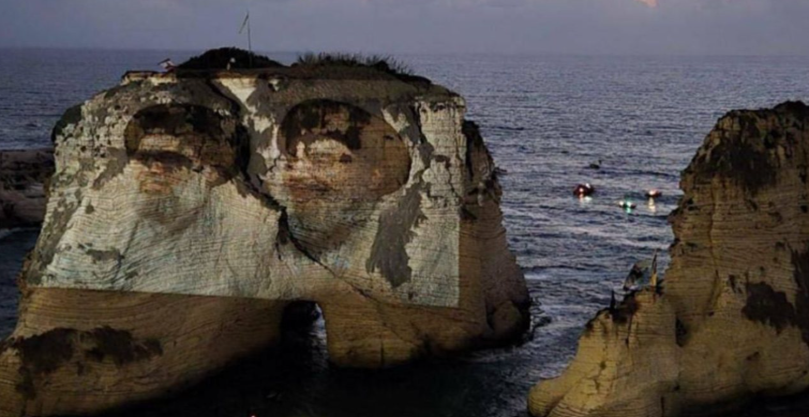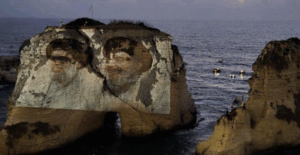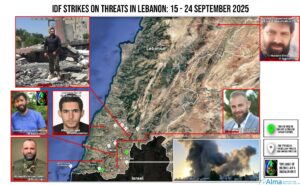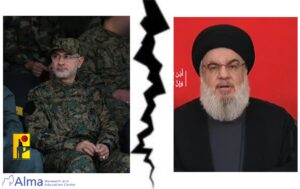On 16 September 2025, Hezbollah inaugurated a series of events commemorating the first anniversary of the elimination of Hassan Nasrallah and Hashem Safi al-Din. During a press conference held at the cultural center of the Ghobeiry Municipality, the principal slogan was unveiled – “Innā ʿala al-ʿahd” (“Truly, we remain bound by the covenant”) – the identical slogan that had been selected for their funeral ceremony.
The series of events commenced on 25 September with the projection of their images onto Al-Raouché Rock in Beirut, accompanied by maritime displays and a synchronized broadcast on over seventy television and radio stations.
The choice of Al-Raouché Rock by Hezbollah was intentional and far from arbitrary.
Al-Raouché Rock (“the Pigeons’ Rock”) is a highly prominent tourist site in Beirut and constitutes one of the city’s most notable symbols. In fact, it consists of two large rocks standing within the Mediterranean Sea at a short distance from the shore, facing the al-Raouché neighborhood.
The very choice of Al-Raouché Rock – a natural site and a conspicuous national symbol in the heart of Beirut – was perceived as a political declaration by Hezbollah of its control over the public sphere and its political presence in the heart of the capital, beyond the borders of its “natural” strongholds.
The Prime Minister, Nawaf Salam, attempted to prevent Hezbollah’s use of the famous site. He responded by issuing a strict governmental memorandum to all authorities, in which he called for stringent enforcement of the laws governing the use of national and public sites – land and maritime – and emphasized the necessity of obtaining official permits prior to any use of sites of national and symbolic value.
This step was understood as a direct attempt to prevent Hezbollah from projecting the images of Nasrallah and Safi al-Din onto Al-Raouché Rock.
Hezbollah did not acquiesce. It swiftly issued a new statement, once more inviting the public and publishing detailed timetables, thereby signaling its intention to proceed despite the opposition.
The intervention of Nabih Berri, aimed at reaching a compromise, did not succeed. After the intervention of the Speaker of Parliament, Nabih Berri, it appeared that a compromise had been reached whereby the event would take place but would comply with legal regulations – in a manner that would reduce the potential for confrontation with Hezbollah’s opponents.
Despite the understandings, Hezbollah carried out the event in full and did not alter its program in any respect. Already from the early afternoon, Hezbollah supporters arrived with flags and images. The Lebanese security forces erected barricades in an effort to preserve order. Nonetheless, tranquility did not prevail, and confrontations ensued between Hezbollah supporters and the security forces.
At the scheduled hour (18:55), the images of Nasrallah and Safi al-Din were projected onto the rock, accompanied by political chants against the government. Hezbollah sent a sharp message: it does not recognize the authority of the state in cases where it perceives an affront to its dignity or to the memory of its leaders.
The violation of the understandings led to urgent governmental deliberations with security agencies. Prime Minister Salam emphasized that this constituted a direct blow to the deterrence of the state. Salam stated that it was a blatant violation of the content of the agreement given to the organizers, which prohibited illumination of Al-Raouché Rock –from the sea, land, or from the air – and forbade the projection of any image upon it. Salam declared that he had instructed the Ministries of Interior, Justice, and Defense to arrest those responsible and bring them in for investigation. According to various reports, Nabih Berri expressed his displeasure and clarified that the violation of the agreement might undermine stability.
We doubt whether the true responsible figures within Hezbollah will in fact be arrested and investigated…
The crisis as a whole underscores Hezbollah’s resolve to restore its image and persist in reinforcing its position at the core of Lebanon’s political and public arena, even at the cost of direct confrontation with the government. This development represents a cognitive-perceptual triumph for Hezbollah, projecting it as unyielding in the face of pressure and as continuing to shape and impose the political agenda.
The cognitive victory at Al-Raouché Rock represents a significant milestone for Hezbollah, both in relation to its Shiite constituency and in its stance toward the government, within the broader discourse on the program of “disarmament.” In practice, this episode underscores that developments will proceed according to Hezbollah’s will; specifically, with respect to disarmament, Hezbollah’s refusal ensures that such a process will not take place.






